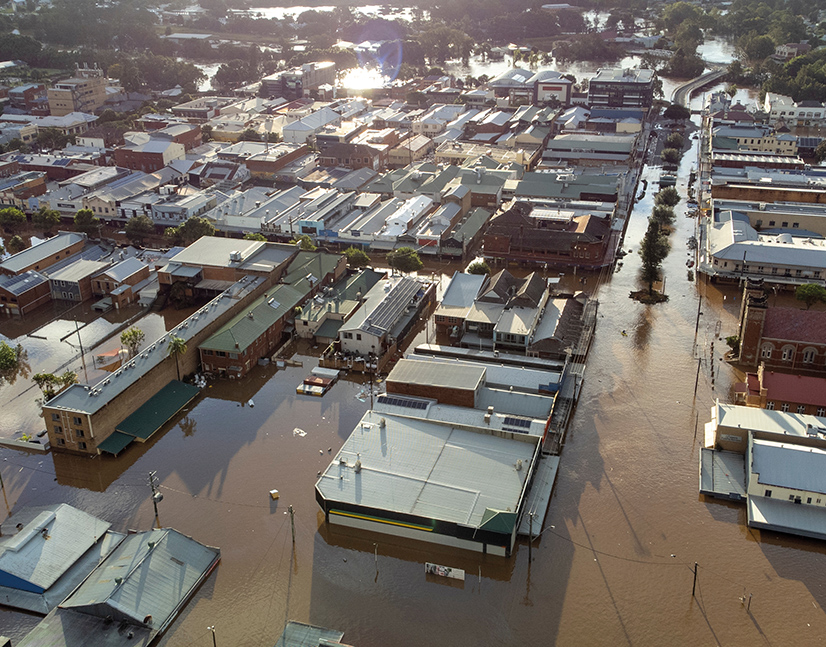
Into the rising tide
Global and local regulators released a swathe of guidelines in the first half of 2021 regarding the incorporation of climate risk into financial institutions’ standard risk-assessment processes. The Australian prudential regulator and banks are largely aligned with the global direction of travel. But they face the unique challenge of managing risk in the face of the issue’s deep politicisation.
Matt Zaunmayr Deputy Editor KANGANEWS
Momentum toward regulatory accounting of climate risk in the world’s financial systems has been building since the Paris Agreement in 2015. This explicitly stated the need to make “finance flows consistent with a pathway towards low greenhouse-gas emissions and climate-resilient development”.
Many financial institutions (FIs) and local regulators have already implemented measures with this outcome in mind. An example is mandatory reporting of climate risk via the Taskforce for Climate-related Financial Disclosures (TCFD). But movement toward uniformity in climate-risk reporting for FIs at a global and national level ratcheted up in the first half of 2021.
In mid-April, the Basel Committee on Banking Supervision (BCBS) released a report entitled Climate-related risk drivers and their transmission channels. This found that the global banking system is exposed to physical and transition climate-change risk through micro- and macroeconomic transmission channels. These can be observed through banks’ traditional risk-assessment categories, according to the BCBS.
On 22 April, the Australian Prudential Regulation Authority (APRA) released for consultation its draft prudential practice guide (PPG) 229 on climate-change financial risks. PPG 229 sets out voluntary best-practice prudential management related to governance, risk management, scenario analysis and disclosure. It is open for feedback from industry participants until 31 July. APRA is aiming to release a final version of the PPG by the end of the year.
Like the BCBS, APRA’s guidance “considers that climate risks can and should be managed within an institution’s broader risk-management framework”.
However, the Australian regulator adds that several elements distinguish the financial risks inherent in climate change from other financial risks. These include the potential for irreversible changes in climate, the diffuse nature of climate risk across the financial system, uncertain time horizons and the unprecedented nature of climate change.
In May the Network for Greening the Financial System (NGFS), of which APRA and the Reserve Bank of Australia (RBA) are members, released a guide for financial-system supervisors on integrating climate-related and environmental risks into prudential supervision. The guide seeks to provide a roadmap for prudential authorities to integrate climate and environmental risks into supervisory frameworks.
LINING UP
The consensus among prudential supervisors appears to be that climate risk can be assessed as part of FIs’ standard risk-assessment practices.
However, to incorporate climate factors adequately in the assessment of standard risk categories such as credit, market, operational and liquidity risk, FIs need greatly to increase their understanding of the potential impacts of climate change on their entire business operations. They also need to report on these in a more uniform manner compared with the currently diffuse reporting standards used across the global market.
In this regard, Zoe Whitton, executive director at Pollination Group in Sydney, says the Australian regulatory approach is broadly in line with the international direction of travel. “APRA’s guidance requires banks to undertake a more uniform process than they have done to date, and to deepen their visibility across focus areas and topics,” Whitton explains.
Internationally, uniformity and depth of disclosure is increasingly the goal of prudential and other regulators on climate risk. Policymakers’ aim around the world is to have visibility of exactly what FIs are invested in, what the climate-related risks of those investments are and what processes are in place for managing them.
Whitton says the intent is evident in the EU’s taxonomy for sustainable finance, in executive orders Joe Biden has signed since becoming US president, and at the recent G7 summit meeting. Debate is ongoing internationally as to whether frontrunners in addressing climate risk should be rewarded or even laggards incentivised. Whitton says, though, that comfort is building in international markets about the idea of capital weights for investments that align with a low-carbon and sustainable economy (see box).
Such a regime could have positive consequences for bank lenders and the sustainable-finance market as a whole. At present, banks offering a margin discount for sustainability-aligned lending do so without any mechanism to offset the discount other than a P&L hit. A regulatory regime that recognises climate risk as a quantifiable financial risk and aligns capital requirements commensurately could square the circle of the desire to lend in a sustainable format but the lack of financial incentive to do so, many bankers believe.
Climate-risk disclosure is not a completely new phenomenon. Australian banks have been voluntarily disclosing climate risk to at least some degree for several years. Most listed Australian banks, including all the big four, do this via the TCFD.
Mark Spicer, head of ESG and responsible investment at KPMG in Sydney, says APRA’s draft guidance provides the next practical steps for building upon this base. He adds that although APRA has been carefully rolling out a climate policy for a few years, FIs’ response to date has been muted.
However, there is scepticism among some market watchers – particularly investors – about whether the Australian draft guidance goes far enough to push FIs into disclosing climate risk. The APRA draft guidance is voluntary, for instance.
APRA’s Sydney-based chair, Wayne Byres, said at the time the guidance was released that the prudential regulator does not foresee a point in the near term at which mandatory disclosure of climate risk becomes necessary. His justification was that banks are voluntarily moving toward this kind of disclosure anyway.
However, Amy Quinton, manager, policy at Investor Group on Climate Change (IGCC) in Melbourne, tells KangaNews that mandatory – or at least more explicit – disclosure guidelines is one area where international regulators and APRA diverge. She references the Monetary Authority of Singapore (MAS) in particular. The MAS has released comparable guidance to APRA but been much more specific in its expectation that FIs disclose their climate risk via reporting on at least an annual basis.
“Explicit guidance on disclosure is an important first step to developing a roadmap that will allow for better understanding of long-term risks in the financial system and how to deal with them appropriately,” Quinton says. “We think APRA should move toward explicit disclosure guidance and that ASIC [Australian Securities and Investments Commission] should take similar action to promote economy-wide disclosure standards.”
On 29 June, IGCC released a report detailing a plan for introducing mandatory TCFD-aligned disclosure in Australia. It says setting clear, mandatory requirements would help align regulators with industry expectations and global standards, as well as reduce reporting burdens by streamlining expectations.
The report suggests starting implementation of mandatory disclosure with ASX300-listed companies and large unlisted entities before progressively extending coverage over time.
Where the rubber hits the road
A clear incentive for banks to align their lending with positive climate outcomes would be capital weightings that explicitly account for climate risk. Such a regulatory setup could immediately facilitate banks to lend to climate-positive projects and borrowers at a cost discount.
The absence of beneficial capital weights has not stopped the development of, for instance, sustainability-linked loans (SLLs) with pricing benefits for borrowers that deliver positive environmental outcomes. Financial institutions (FIs) globally have also come under increasing stakeholder pressure to make capital-allocation decisions that align with a low-carbon future.
At the same time, many FIs have made the point that environmental transition is not a black-and-white issue – thanks to, for instance, the intersection of social and environmental outcomes in fossil-fuel industries.
The SLL is one mechanism used to deal with this dilemma. This type of lending offers margin incentives for corporations – often in heavy emitting sectors – to meet various environmental, social and governance-related KPIs.
ADDITIONAL LAYERS
The release of APRA’s draft guidance did not appear to cause much of a stir in Australia’s FI sector. Submissions made to the consultation are expected to air any concerns around the guidance. In the meantime, the gulf between what Australian FIs are doing to manage climate risk now compared with what they will need to do to meet APRA’s guidelines is under the microscope.
TCFD reporting has historically focused on the material risks to an FI’s portfolio that are already measurable. APRA’s guidance should coax FIs into assessing the climate risk of parts of businesses that have hitherto either not been considered or not been possible to consider.
“Getting to a point where all FIs comply with every part of APRA’s guidance in complete depth will be a journey that takes years rather than months,” Whitton suggests. “Most will begin with the information they already have access to. At the same time, they will need to put in place processes that build greater visibility of climate risk across all areas of the business.”
Whitton compares the process to building a plane at the same time as flying it, given the urgency of action on climate change and the level of momentum already in the sustainable-finance market. She identifies liability risk as a particular area APRA has identified in which Australian FIs will quickly need to develop expertise so they can understand the risks of stakeholder litigation and regulatory enforcement they may face.
Evidence of climate-related liability risk already exists. For instance, late last year superannuation fund REST settled a dispute with a member who sued the company for failing properly to disclose its management of climate risk.
“FIs are trying to manage risk in a situation where their risk management can be politicised. Meanwhile, regulators are having to deal with the question of whether the nation should be pushing capital toward sustainable investments because of the impact this might have on some incumbent industries.”
Physical and transition risks are likely to be the majority of those that manifest for FIs, though. APRA – like global bodies such as the BCBS – is keen for deeper understanding of these to be developed. The scenario analysis APRA proposes in PPG 229 will be important here, Quinton says. The draft guidance says FIs could make long-term assessments of their future exposures based on different climate-related scenarios such as global temperatures rising by 4 degrees, or 2 degrees or less, by 2050.
Quinton says this would be a good start and is important to undertake. But she adds that investor demand is coalescing around business alignment to a future with warming of 1.5 degrees or less by 2050, in line with the Paris Agreement.
Spicer says regulatory advice that physical and transition climate risks should show in FIs’ assessments of credit and operational risks is reasonable. However, he adds, FIs are only at the very beginning of understanding the climate risks they face within these categories – let alone collecting the information needed to accurately identify and price them.
“The pathways for climate risk to be realised as a credit risk are myriad and complex. Climate risk does not just appear in a factory or asset owned by a company. It is throughout complex company supply and value chains. This makes risk more difficult to identify. Deeper understanding and more data is needed. FIs and other companies are only just starting to collect data let alone ascribe value to them,” Spicer comments.
BCBS identifies the data delta as an obstacle in its report. It acknowledges: “Existing analysis does not generally translate changes in climate-related variables to changes in banks’ credit, market, liquidity or operational risk exposures or to bank balance-sheet losses. Instead, the focus is on how specific climate-risk drivers can impact: narrowly defined sectors of particular economies, individual markets and a top-down assessment of the macro economy as a whole.”
The report calls for more research and data to be made available so the BCBS can better understand the risk climate change poses to the financial system.
APRA is planning to do its part. Alongside the PPG 229 consultation it is undertaking climate vulnerability assessments (CVAs) with Australia’s five largest banks. These are in effect stress tests to assess the vulnerability of FIs, the financial system and the economy and then understand how FIs might adjust business models to account for the various challenges of climate change.
The results of the initial CVAs are expected in the fourth quarter of 2021. APRA intends to roll out CVAs across the banking, insurance and superannuation sectors. Spicer says the lessons from initial CVAs should help build capacity and data within FIs as well as at the system level.
THE WILL AND THE WAY
As large an obstacle as the data and reporting capability gulf is, perhaps the biggest issue to be addressed in Australia is the country’s peculiar bifurcation of views on what FIs should be doing about climate risk.
APRA, along with its Council of Financial Regulators peers the RBA and ASIC, is clearly signalling that FIs need to gain a better understanding of their climate risk so they can make appropriate investment and business decisions. Meanwhile, the federal government remains at best stubborn and at worst outright antagonistic toward FIs using climate risk as a justification for capital-allocation decisions it does not agree with.
Australia is unique, at least among developed nations, in this regard. In most jurisdictions, particularly since the last US presidential election, regulators are aligned with government in the desire to direct as much capital as possible toward climate resilience and sustainability. In Australia, the debate – politically at least – still rages as to whether or not this is in the national interest.
The elevation of Barnaby Joyce to the office of deputy prime minister on 22 June, on an adamant anti-net-zero by 2050 platform, is just the latest example of this.
Whitton says: “FIs are trying to manage risk in a situation where their risk management can be politicised. Meanwhile, regulators are having to deal with the question of whether the nation should be pushing capital toward sustainable investments because of the impact this might have on some incumbent industries.”
Perhaps APRA’s guidance, along with the plethora of international movement, gives local FIs the ammunition to cut through the politicisation of the climate issue – should they wish to do so. Quinton says the guidance is at least important to provide a strong signal to the industry on what action is required.
It is clear that understanding and disclosing climate risk will be crucial if Australian banks are to keep pace with international developments. Spicer says evidence is already gathering in Europe to suggest institutions that do not account for climate risk properly will likely find it more difficult, or at least more expensive, to access capital.
Quinton tells KangaNews inaction, or even disjointed action, by Australian regulators is a clear and present risk to capital flows into and out of the country.
“Internationally, mandatory TCFD regimes are rapidly becoming the norm. It is not a question of if this will be required by Australian companies, just how and when. Australian regulators need to step up and be practically involved to ensure we have a regulatory regime that is fit for purpose. Proactively working toward a TCFD-aligned economy will provide clarity,” Quinton says.

HIGH-GRADE ISSUERS YEARBOOK 2023
The ultimate guide to Australian and New Zealand government-sector borrowers.

WOMEN IN CAPITAL MARKETS Yearbook 2023
KangaNews's annual yearbook amplifying female voices in the Australian capital market.














